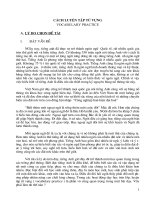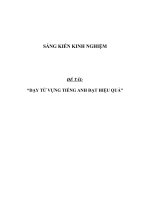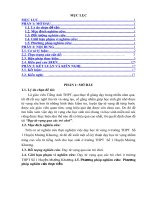SKKN day tu vung
Bạn đang xem bản rút gọn của tài liệu. Xem và tải ngay bản đầy đủ của tài liệu tại đây (78.24 KB, 8 trang )
Seminar on methodology : “How to teach vocabulary effectively”
Acknowledgement
Firstly, I would like to express my sincere thank to all the leaders of Phuc
Yen Education and Training Department for organizing this seminar and for giving
me the precious chance to do it.
Secondly, I am very grateful to all the teachers of English in Cao Minh
school for offering me useful advice in realizing my ideas.
Lastly,thank you very much for your presence and observation. Your
comments and advice would be highly appreciated.
Thank you very much.
A.aims:
Ng« ThÞ Thu HiÒn
1
Seminar on methodology : “How to teach vocabulary effectively”
Vocabulary words are simple enough to begin learning on the first day of a
class and they are powerful enough to encourage communication from the very
beginning .Words are small pieces of language which carry bits of
meaning.Knowing many words does not guarantee a person will be able to speak a
language ,but not knowing words can prevent a person from effectively speaking or
understanding a language.That’s why vocabulary must be taught from the very
start.
In the new text book series (Tieng Anh 6 – Tieng Anh 9 ),
vocabulary is enlarged so much to provide four main skills : Listening , Speaking ,
Reading and Writing. Therefore , teachers must have the most effective metthod
of teaching vocabulary to present vocabulary effectively.A good method of
teaching vocabulary will get more students’ attentions.
This seminar aims at two main points :
First : To show teachers several principles for teaching vocabulary .
Second : To show teachers a range of steps for teaching vocabulary
It is hoped to bring about all of you here some good hints.
B.content:
I. What vocabulary to teach?
II. Principles for teaching vocabulary
III. Steps for teaching vocabulary
IV. Checking vocabulary
I. What vocabulary to teach ?
Ng« ThÞ Thu HiÒn
2
Seminar on methodology : “How to teach vocabulary effectively”
As you know,there are two types of vocabulary .They are : Passive
vocabulary and active vocabulary .
Passive vocabulary are words which a student can recognize but
not necessarily use in speaking or writing .If a student sees a word in their passive
vocabulary ,he/she will understand what it means .Passive vocabulary words are
especially useful for receptive skills of reading and listening.
Active vocabulary are words which students can both understand
and use in communication .Active vocabulary words are especially useful for the
productive skills of speaking and writing .
∗The process of vocabulary expansion looks something like this:
Unknown - > Passive vocabulary -> Active vocabulary
A teacher should expect his/her students to understand words in reading and
listening before they can use those same words in speaking and writing .When
teaching , it is best to first train students to recognize words .Later the teacher will
find the students can actively use those same words in communication.
II.Principles for teaching vocabulary :
There are many different ways of teaching vocabulary ,but some ways are
more effective than others.
1. Provide a context for new words : We will help the students guess the
meanings of the new words and remember easilier.
E.g : The word “ study”
Grammatical context : “Children go to school to study”
( students can guess “study” is a verb and an action happening
at school)
2. Do not present too much new words at once .Teach a few words and
allow students to practise and use them a lot . This will help them
remember new words easily.
Ng« ThÞ Thu HiÒn
3
Seminar on methodology : “How to teach vocabulary effectively”
3. Practising new words in context is more important than memorizing
isolated words .Students may be required to learn the meanings of words
but they must also be given the opportunity to use them productively in
speaking and writing.
4. Teach your students skills for guessing new words , especially when
reading .The meaning of words can be inferred from the different types of
contexts and from looking at affixes (parts) of the word.
E.g: My mother teaches at Cao Minh school
What is a teacher ?
( Students can guess from the suffix “-er” that “a teacher is a person
who teaches students” )
happy>< unhappy
.. .……
5. Avoid translation as much as possible. If the students are always having
words translated, they are really only communicating in their own
language , not in Eglish. Also, students do not usually remember
vocabulary that has been translated.Only use translation as a last resort ,
when it would otherwise take too long to communicate in English.
6. Avoid using the dictionary a much as possible .When reading or listening
,students should first try guessing or ignoring new words so that they can
continue without stopping .Also using a dictionary when speaking or
listening often slows down communication .In writing ,using a dictionary
can be beneficial.It helps students express themselves more clearly.
7. Practise the new words in context first ,practise in chorus ,and then
individually.
8. Active words are needed to teach first,ignore the passive words.
Those are the priciples for teaching vocabulary . Have you taught vocabulary
follow those principles ? In my opinion , If all of us follow those principles strictly,
we will get the best feedback from our students .Do you agree with me???
Ng« ThÞ Thu HiÒn
4
Seminar on methodology : “How to teach vocabulary effectively”
III.steps for teaching vocabulary :
1.Presentation:
a.Present pronunciation : By reading words in context , emphasise it by some
receptions.
E.g : My father has got a car
b. Present dictation : Write new words on the board and then helps students copy
them in their notebooks.
c. Present the meanings of new words : There are 12 techniques for
communicating the meanings of words .
c1. Paraphrase and define : We can explain a word by using a different
word,words or a definition
E.g : A boy is a male child
A car is a vehicle that carries people
A jacket is also called a coat
c2. Drawing : We can draw a picture of some words on the board that will
quickly convey the meanings
E.g: -> happy
-> sad
c3.Realia and objects : When we teach abut nouns in semantic fields , We
can bring a series of real object to class.
c4. Flash cards or charts: We can use flash cards or charts on which we
have a picture on one side and words on the other side
E.g : Flash cards with animals on them
Cards with vehicles on them
A chart with body parts marked
c5. Mime: We can act out to demonstrate its meaning ( ofcourse,without
saying )
Ng« ThÞ Thu HiÒn
5









